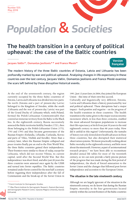The health transition in a century of political upheaval: the case of the Baltic countries
Press release Published on 16 May 2018
Population & Sociétés n° 555, mai 2018

The modern history of the three Baltic countries of Estonia, Latvia and Lithuania has been profoundly marked by war and political upheaval: annexation by the Russian Empire, independence after the First World War, forced integration into the USSR, renewed independence after the collapse of the Communist regime, and finally admission to the European Union. Analysing changes in life expectancy in these countries over the last century, Jacques Vallin, Domantas Jasilionis and France Meslé examine the scars left behind by these disruptive historical events.
Variations in life expectancy in the Baltic countries are instructive as they tell us about the possible links between geopolitical upheavals in the region at the edge of the Russian Empire, and later of the USSR, and the progress of the health transition. Well ahead of Russia at the time of their first independence, Estonia, Latvia and Lithuania paid a heavy price when they were forcibly integrated into the USSR.
Nonetheless, the losses incurred were soon reversed thanks to the remarkable success of the Soviet regime in reducing infectious mortality. The entire USSR, led by the Baltic countries, soon began to catch up with the West in terms of life expectancy. However, this same Soviet health system proved incapable of combating cardiovascular diseases or controlling the upsurge in social diseases. As a consequence, life expectancy in the Baltic countries started lagging behind that of the West. Finally, as in Russia, the transition to a market economy after the fall of communism and the break-up of the USSR was so brutal that in 1993-1994 male life expectancy fell back to the levels of the 1950s.
It was only from 1995, in the context of independence, and preceding their accession to the European Union, that these countries were able to implement policies that produced a sustained increase in life expectancy and a convergence towards western European standards.








